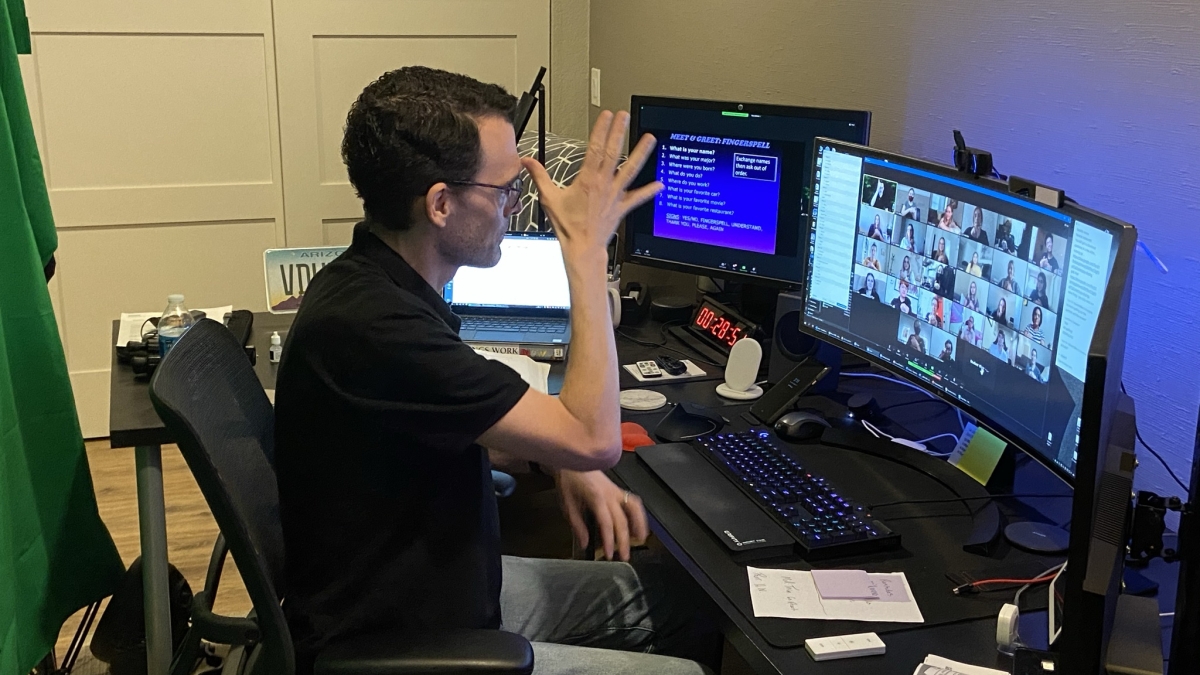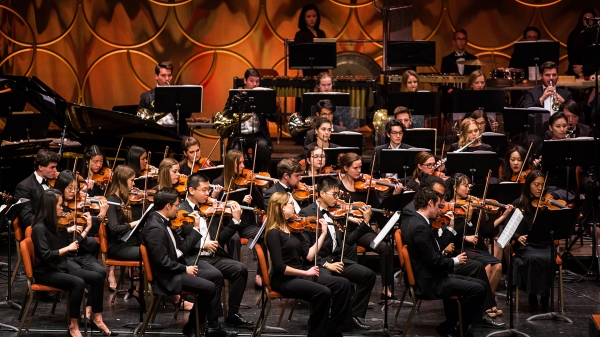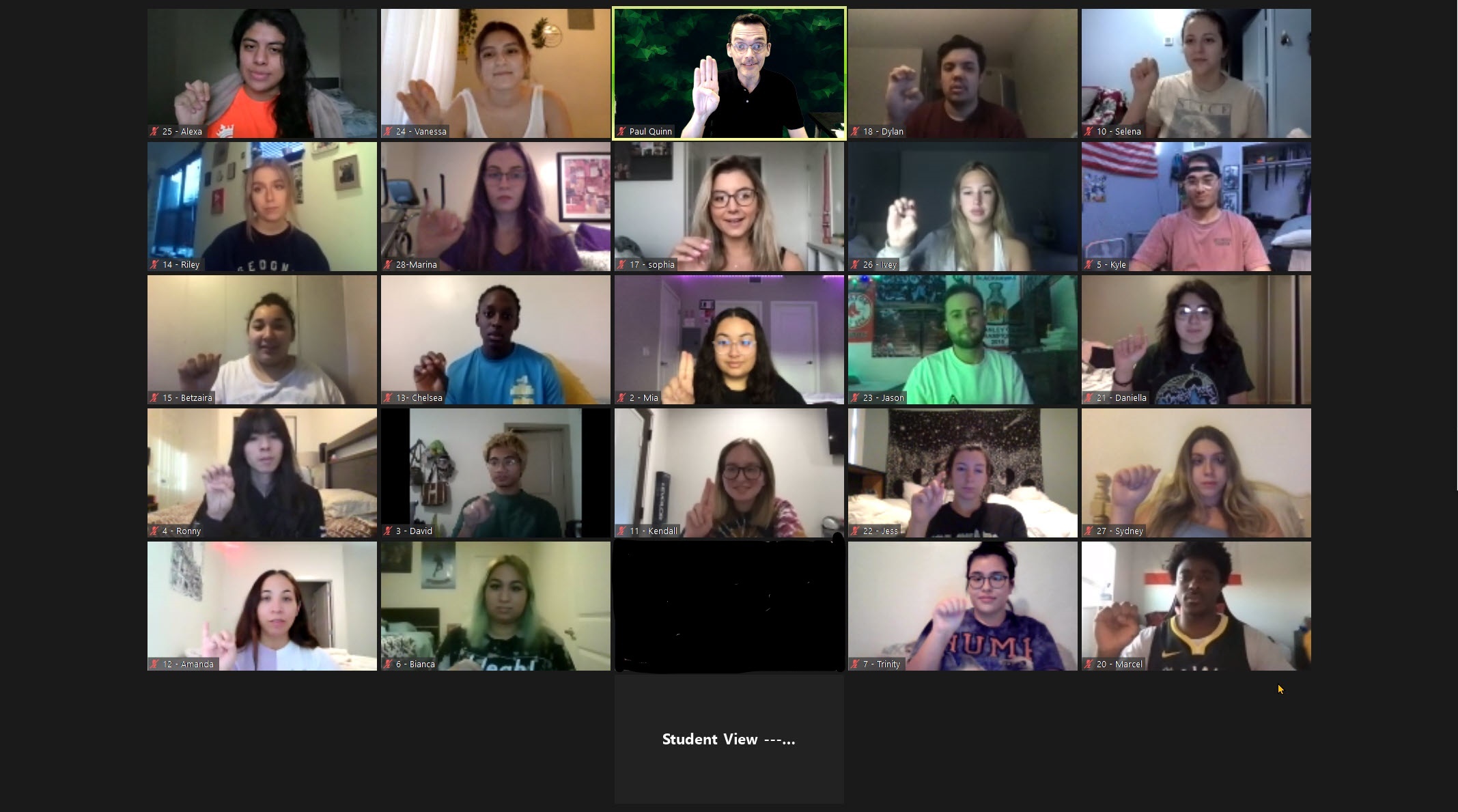American Sign Language students, professors adapt to virtual learning

ASL Lecturer Paul Quinn demonstrates a sign for his students, who are watching via Zoom video. Quinn uses multiple monitors as well as a laptop and desktop computer as part of his setup so that he can monitor his class while also seeing his own video feed and accessing course materials.
With the shift to mostly virtual classes this year, American Sign Language (ASL) students and professors at Arizona State University have had to get creative with their approaches to language learning.
Psychology sophomore Alexa Velasquez had to experiment with how to arrange the Zoom display on her laptop so that she could see her professor and all of her classmates at the same time, plus access course materials like PowerPoint presentations.
Kyle Erlandson, a junior studying graphic design, learned to regularly scan the grid of faces on his screen to check if a classmate was waving to get his attention.
And Paul Quinn, a lecturer in the School of International Letters and Cultures, added several monitors to his desk so that he could view his students on one screen, his own camera feed on another, and his instructional materials on a third display.
“I feel like I am producing a television show for every class,” he said after explaining his elaborate setup.
Quinn’s classes are taught in an immersive style with no spoken English communication. Even though many students begin his American Sign Language I class with no previous knowledge of ASL, they quickly master the signs for basic vocabulary words and conversational phrases. As a last resort, students can use the chat box on Zoom to ask questions or clarify what they are trying to sign.
“This class is fully immersive, so we do not talk, and I think that’s the best way,” said Erlandson, who is currently enrolled in one of Quinn’s American Sign Language I classes. “It challenges you to really learn the language and not rely on voice.”
Rather than just watching their professors demonstrate signs, students sign along with them, which helps the students stay engaged and become more comfortable with a different communication method. Individual lessons can focus on linguistic elements like grammar, vocabulary, or sentence structure. Students can use breakout rooms to practice one-on-one with a partner or in small groups, signing entire conversations as the instructor drops in to observe their technique.
Quinn’s classes are taught using ASU Sync, which allows students who prefer an in-person learning environment to attend class on campus at the same time as their peers studying from their dorm rooms or homes. However, most students have chosen a fully remote learning style, which gives them greater control over variables like internet signal and camera position.
“It’s sometimes hard seeing other people signing online because of many reasons, such as lighting, internet speed and connectivity, how close or far away someone is from their camera, and overall learning how to work everything virtually,” Velasquez said. She prefers in-person classes, but has adjusted to learning ASL remotely. “It’s still fun and manageable once the initial hurdles are over with!”
Students in ASL Lecturer Paul Quinn's American Sign Language I class practice fingerspelling sentences to improve their skills.
Students who choose to learn in person have to wear face coverings in their classrooms, which presents another obstacle. Facial expressions are an important component of ASL in addition to signs. They can convey emphasis and other valuable details such as the size of an object being discussed or the type of question being asked. Face masks leave a person’s eyebrows visible, which grants them some ability to convey extra information, but it’s not ideal.
“In ASL, masks seriously impact the message by blocking important expressions that are part of ASL. Natural expressions are blocked as well,” Quinn said. “Many people don’t understand that ASL is more than hands.”
Hannah Hawkins, a junior studying psychology, has taken both in-person and virtual ASL classes at ASU. She said there are a lot of challenges associated with virtual ASL instruction, but she appreciates that the remote format does offer the benefit of being able to communicate without wearing face coverings.
“In ASL, a lot of signs have grammatical differences that lie in the way you hold your face when completing the sign. With masks on, reading these facial cues is very difficult, if not completely impossible,” Hawkins explained.
However, several students agreed that in-person instruction is the best possible format for ASL learning. They look forward to returning to the classroom soon so that they can more naturally converse with their classmates. Their professors, too, miss the opportunity to closely observe the students as they sign to each other.
Hawkins also said that in-person instruction offers more opportunities to sign with a variety of classmates and grow familiar with different styles of sign language. The breakout rooms utilized by Quinn and other ASL professors on Zoom help to replicate this experience even if students aren’t in a physical classroom location together.
“Each person who signs has their own personal style, even if we are all learning the same thing,” Hawkins said. “Being exposed to more than one person in a single class period can help you learn to better adapt to understanding possible differences in sign styles that you might come across.”
Quinn has invested a lot of extra time in adapting his ASL courses for the virtual format. Beyond the addition of his multiple monitors, he also takes steps to make sure his personality comes through across the video format, so that students don’t see him as “only a two-dimensional figure.” His in-person classes in previous semesters had a vibrant and active energy that encouraged students to socialize with each other and develop friendships, so he works hard to channel that liveliness over Zoom.
“It adds a layer of difficulty, but we make it work,” he said. “I still find it amazing that my students knew no sign language in August and only a few months later, they are communicating fully in ASL. It’s particularly incredible in this pandemic environment.”
More Arts, humanities and education

ASU Symphony Orchestra welcomes visionary conductor Jonathan Taylor Rush
Guest conductor Jonathan Taylor Rush will join Arizona State University’s Jason Caslor, director of bands, to lead the ASU…

Chemistry classes are key to art student's success
Amanda Barnette has a passion for art preservation. That means that, for the past four years, the Arizona State University…

ASU+GSV Summit tackles big questions about AI, technology, education
Editor's note: We'll be updating this story daily throughout the summit. The annual ASU+GSV Summit kicked off in San Diego on…
